Hands-on learning is one of the most effective ways to learn new skills. It allows learners to experience and practise real-world scenarios, building their confidence and knowledge. However, not all learners are created equal, and some may struggle to keep up with the pace of the training or grasp the concepts fully. That’s where skill bundles come in. In this blog, we will explore how skill bundles can empower learners to maximise their learning potential during hands-on training.
What are skill bundles?
A skill bundle is an all-inclusive learning package that includes curated content, expert mentoring, interactive playgrounds, and most importantly, hands-on labs. These labs for upskilling offer learners the opportunity to apply the theoretical concepts they’ve learned in a practical setting, thereby solidifying their understanding and boosting their confidence. With Skill Bundle, you get access to a dynamic, immersive learning experience that fosters growth and development. It’s the perfect platform for acquiring new skills, deepening your expertise, or advancing your career.
Moreover, Skill Bundle is a comprehensive learning management system (LMS) that allows training teams and L&D teams to manage all aspects of the learning journey, from the student’s perspective to the trainer’s point of view, making it a one-stop-shop for all your learning needs. In the context of hands-on training, skill bundles are a collection of skills that are essential for mastering a particular task, making you task-ready, job-ready, or project-ready.
The Benefits of Skill Bundles
Skill bundles offer several benefits that can help learners maximise their learning potential during hands-on learning in the training process.
Here are a few of them:
- A Clear Learning Path
Skill bundles provide a clear learning path for learners, making it easier for them to understand what they need to learn and in what order. This clarity can help learners feel more confident and motivated, as they can see their progress as they move through the training.
- Focused Learning
Skill bundles allow learners to focus on the specific skills they need to master, rather than being overwhelmed by a broad range of topics. This focused learning can help learners grasp the concepts more quickly and apply them effectively.
- Increased Efficiency
Skill bundles can help learners save time and effort, as they don’t have to switch between unrelated skills. This can increase efficiency and productivity, allowing learners to achieve their learning goals more quickly.
- Adaptive Learning
Skill bundles can be tailored to individual learners’ needs and abilities, providing a more personalized learning experience. This adaptability can help learners overcome their weaknesses and build on their strengths, ultimately improving their overall performance.
Implementing Skill Bundles in Hands-On Training
Did you know that hands-on training can increase knowledge retention by up to 75%? This is compared to other forms of training, such as lectures or reading, which have a retention rate of around 5%. This demonstrates the power of hands-on labs for the hands-on training process and the importance of using them to their fullest potential.
By implementing skill bundles in hands-on training, learners can benefit from the increased efficiency, focused learning, adaptive learning, and clear learning path that they provide. These benefits, combined with the proven effectiveness of hands-on training, make skill bundles an essential tool for maximising learning potential and achieving success in today’s job market.
Implementing skill bundles in hands-on training is a straightforward process. Here are some steps you can follow:
- Skill bundles are like power-ups for your learning journey! They combine curated content, interactive projects, expert mentoring, and more to help you achieve your desired learning outcome.
- With skill bundles, you’ll gain the knowledge, skills, and confidence you need to excel in your chosen field while engaging in a dynamic, immersive learning experience that fosters growth and development.
- Trainers work with technical teams to build skill bundles for each training title, which can be used any number of times to deliver training.
- Daily assessments can be set up to assess students on that day’s topics, and projects can be categorised into conceptual, guided, and assessment projects.
- Conceptual projects integrate Playground Lab with self-paced video content or instructor-led programs to help learners gain a deeper understanding of concepts while simultaneously applying them in a practical environment.
- Guided projects give learners specific exercises to complete within the Playground Lab, providing immediate feedback on their progress and helping them master a particular skill or reinforce their understanding of a particular concept.
- Assessment projects simulate real-world scenarios as problem statements to be solved within the Playground Lab, helping learners develop practical skills they can apply in their careers.
- After the training, a comprehensive post-training assessment can be conducted to evaluate the effectiveness of the program and measure the extent to which learners have achieved the intended learning objectives.
- The post-training assessment can help identify knowledge gaps, evaluate the effectiveness of the program, provide feedback on the learning experience, and give insights into learners’ progress.
- At the end of the training, learners are given a feedback form where they can provide their feedback on the overall objectives, the facilitator, the contents, and the infrastructure (labs).
- Feedback on overall objectives, facilitators, contents, and infrastructure can provide valuable insights into the effectiveness of the training program, and individual remarks can provide detailed and specific feedback on the learning experience.
Conclusion
Hands-on training is a powerful tool for learning new skills, but it can be challenging for some learners to keep up with the pace and complexity of the training. Skill bundles can help learners maximize their learning potential by providing a clear learning path, focused learning, increased efficiency, and adaptive learning. By implementing skill bundles in hands-on training, trainers and educators can provide a more effective and personalised learning experience, helping learners enable skill outcomes and also achieve their goals more quickly and confidently.




